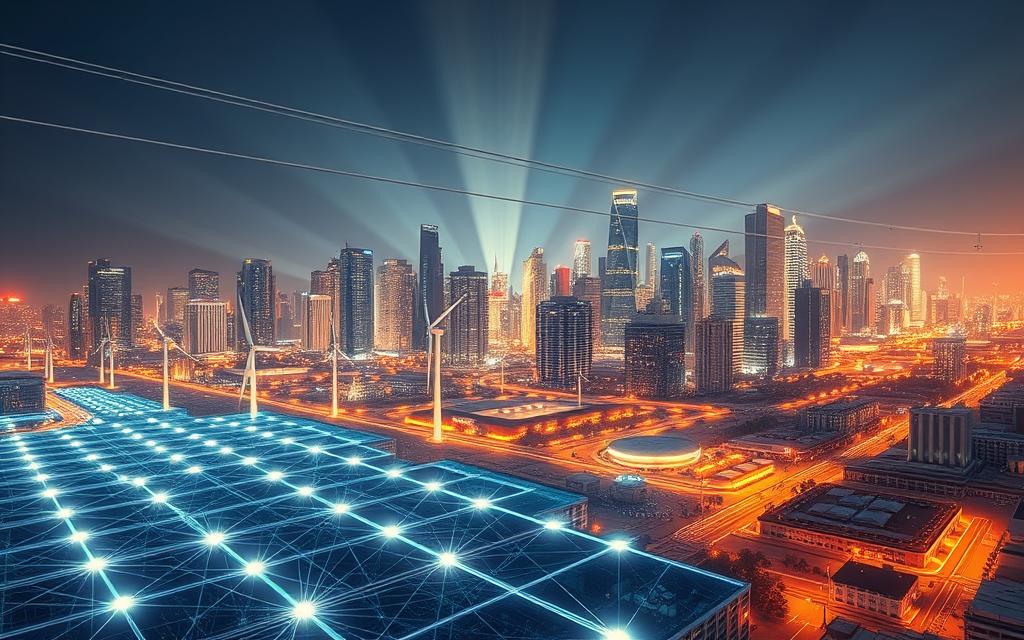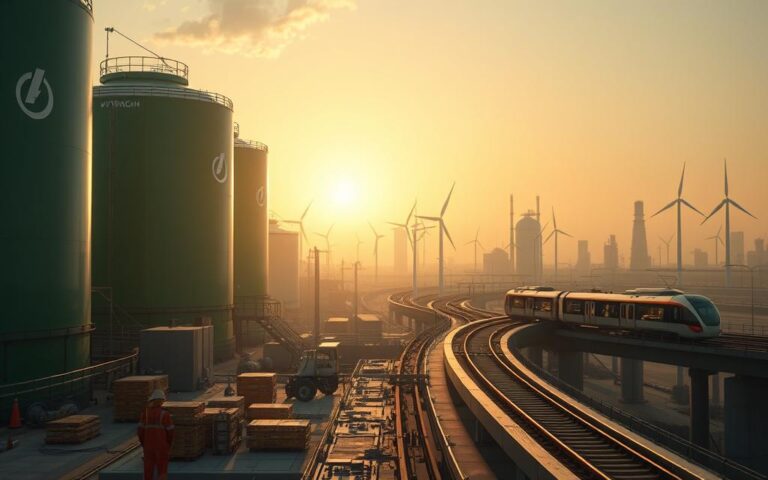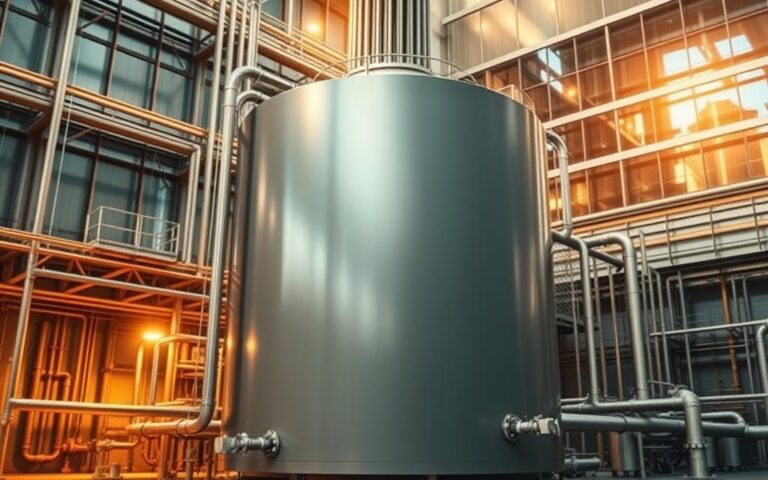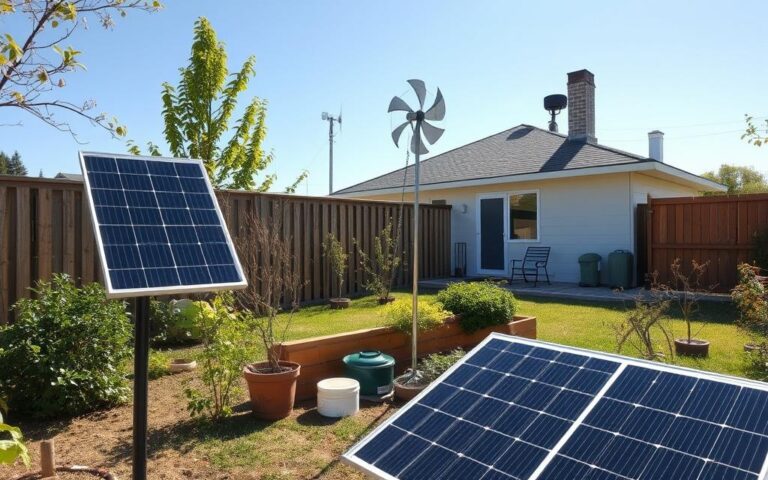
AI could slash renewable energy costs by 30% in the next decade. This tech revolution is changing power generation across the United States. It’s a game-changer for sustainable energy.
AI optimization is becoming crucial for energy providers. Smart algorithms predict energy production with amazing accuracy. They also manage grid stability and boost resource efficiency.
AI helps renewable energy systems adapt to complex patterns. It uses neural networks and predictive analytics for real-time performance optimization. This greatly improves sustainable energy infrastructure.
As climate issues grow, AI’s role in power systems becomes vital. It fills gaps in renewable energy management. AI promises a smarter, more responsive energy future for generations to come.
Understanding the Role of Artificial Intelligence in Energy Systems
AI is transforming renewable energy, offering new ways to optimize and improve efficiency. Machine learning helps manage complex power systems better. It enables smarter decisions and better resource allocation.
Advanced computational techniques have opened new doors in energy management. AI provides crucial insights for energy providers. These insights help tackle complex challenges in power generation and distribution.
Machine Learning Fundamentals for Energy Management
Machine learning algorithms process vast amounts of data from energy systems. They excel at this task. Their key applications include:
- Predictive maintenance for power infrastructure
- Real-time demand forecasting
- Grid stability optimization
- Renewable energy resource mapping
Deep Learning Applications in Power Systems
Deep learning is changing how we manage energy. Neural networks can analyze complex patterns with amazing accuracy. They look at energy consumption, generation, and distribution in new ways.
Neural Networks for Energy Optimization
Neural networks help smart systems get better over time. These advanced algorithms can do many things. They predict energy use patterns and make renewable energy work better.
- Predict energy consumption patterns
- Optimize renewable energy integration
- Enhance grid resilience
- Reduce operational costs
The future of sustainable energy lies in leveraging artificial intelligence to create more responsive, efficient, and intelligent power systems.
Current Challenges in Renewable Energy Integration
Switching to renewable energy brings major challenges that need smart solutions. These issues slow down the adoption of sustainable power systems across the US.
Key obstacles in sustainable power include:
- Intermittency of renewable energy sources
- Grid stability and infrastructure limitations
- Energy storage capabilities
- High initial infrastructure investment
Renewable energy systems face complex technical hurdles. Wind and solar power generation depend on unpredictable natural conditions. This creates big swings in power output.
Such variability makes it hard for utility providers to deliver consistent energy. It also poses challenges for grid stability and management.
| Challenge | Impact | Potential Solution |
|---|---|---|
| Power Intermittency | Unstable Grid Performance | Advanced Energy Storage |
| Infrastructure Limitations | Reduced Energy Transmission | Smart Grid Technologies |
| High Implementation Costs | Economic Barriers | Government Incentives |
Solving these renewable energy challenges needs well-rounded strategies. New tech like AI and machine learning offer promising ways to overcome these obstacles.
AI in Sustainable Energy: Transforming Power Generation
AI is revolutionizing renewable energy production and management across the United States. Advanced technologies are reshaping how we handle sustainable energy resources. This transformation is making power generation more efficient and responsive.
Renewable energy systems now use predictive analytics to boost performance. Intelligent algorithms help energy providers tackle power generation challenges. This integration allows for precise responses to changing energy needs.
Predictive Analytics for Energy Production
Predictive energy analytics enables energy producers to:
- Forecast energy output with remarkable accuracy
- Identify potential system inefficiencies
- Minimize unexpected downtime
- Optimize renewable resource utilization
Smart Grid Integration Solutions
Smart grid AI solutions are improving electrical infrastructure. They create more responsive and adaptive energy networks. These intelligent systems offer several benefits:
- Balance energy supply and demand in real-time
- Integrate diverse renewable energy sources
- Enhance grid stability and resilience
Real-time Energy Distribution Management
AI technologies allow instant monitoring of energy distribution. These systems analyze complex data streams quickly. They make fast decisions to optimize power transmission and reduce waste.
“AI is not just transforming energy production—it’s redefining our entire approach to sustainable power management.” – Energy Innovation Research Institute
The future of renewable energy depends on AI and smart grid technologies. These innovations will continue to evolve. We can expect more efficient and sustainable energy systems as a result.
Machine Learning Algorithms for Energy Forecasting
AI has transformed renewable energy forecasting. It offers high accuracy in predicting power generation and use. This helps energy operators boost grid performance and cut uncertainty.
Advanced algorithms analyze complex data patterns for renewable energy forecasts. These smart systems process many variables. They include:
- Historical weather conditions
- Solar radiation intensity
- Wind speed measurements
- Geographical terrain characteristics
Advanced neural networks turn raw data into useful insights. They use deep learning to predict energy output precisely. This helps utility companies make smart choices.
These networks guide decisions on resource use and grid management. They process vast amounts of data quickly and accurately.
“Machine learning has become the backbone of modern renewable energy forecasting, enabling unprecedented grid stability and efficiency.” – Clean Energy Research Institute
Energy forecasting AI cuts costs and boosts resource allocation. It also improves grid reliability. Utility managers can now better predict energy changes.
This ensures smoother integration of renewable sources into power grids. It also leads to better overall system performance.
Machine learning predictions keep improving. This promises even better forecasting models soon. The renewable energy sector is moving towards new levels of efficiency.
Smart Grid Optimization Through Artificial Intelligence

AI is transforming power infrastructure with smart grid technologies. It enables utility companies to turn traditional networks into intelligent systems. This breakthrough enhances energy management and efficiency.
AI technologies bring new capabilities to power distribution networks. Energy providers focus on smart grid stability to improve reliability.
Grid Stability Enhancement
AI-driven grid stability solutions offer several advantages:
- Real-time monitoring of electrical infrastructure
- Predictive maintenance algorithms
- Rapid fault detection and mitigation
- Dynamic load management
Demand Response Management
Demand response AI helps utilities adjust energy consumption patterns. It analyzes complex data streams for precise load management. This is especially useful during peak consumption periods.
Load Balancing Techniques
Machine learning algorithms improve load balancing techniques. These smart systems distribute electrical loads efficiently.
- Predict energy consumption trends
- Optimize power distribution
- Minimize transmission losses
- Integrate renewable energy sources seamlessly
The future of energy management lies in intelligent, adaptive systems that can respond instantaneously to changing electrical grid requirements.
Solar Power Generation and AI Integration
AI is revolutionizing solar power in the U.S. It’s reshaping how we generate, manage, and optimize solar energy production. Smart solar systems are leading this change.
AI makes solar energy optimization more advanced. Machine learning helps solar installations predict and maximize energy output with great accuracy.
- Advanced predictive analytics assess solar panel performance
- Real-time monitoring tracks energy generation efficiency
- Dynamic adjustment of solar panel angles for maximum sunlight capture
Intelligent solar systems are not just improving energy production—they’re fundamentally changing our approach to renewable energy management.
“AI transforms solar technology from passive infrastructure to an adaptive, intelligent energy ecosystem.” – Clean Energy Research Institute
AI has key uses in solar power:
- Precise solar irradiance forecasting
- Automated maintenance scheduling
- Grid integration optimization
The future of solar energy relies on AI. Smart tech can greatly boost solar system efficiency and reliability.
Wind Energy Optimization Using Machine Learning
AI is transforming wind energy optimization in remarkable ways. Machine learning tech boosts wind farm efficiency across the United States. These innovations are reshaping renewable energy production.
Smart algorithms enable wind farms to reach new heights in performance. Energy producers can now predict and improve turbine output with incredible accuracy. This leads to smarter, more efficient wind power generation.
Turbine Performance Prediction
Advanced models analyze complex data to forecast turbine performance precisely. This helps wind farm operators spot issues early. It also allows them to optimize energy production in real-time.
- Identify potential performance issues before they occur
- Optimize energy generation based on real-time conditions
- Minimize unexpected equipment failures
Weather Pattern Analysis
AI algorithms study intricate weather patterns for strategic energy production. This deep understanding of micro-climates helps turbines adjust for peak efficiency. Wind farms can now adapt to changing conditions instantly.
“AI is transforming wind energy from a variable resource to a precisely managed power generation system.” – Clean Energy Research Institute
Maintenance Scheduling Optimization
Machine learning has revolutionized wind power maintenance strategies. Predictive and proactive equipment management is now possible. This cuts downtime and operational costs significantly.
| AI Optimization Technique | Performance Improvement | Cost Reduction |
|---|---|---|
| Predictive Maintenance | 25% increase in turbine uptime | 18% reduction in maintenance expenses |
| Weather-Adaptive Positioning | 15% higher energy generation | 12% operational cost savings |
Wind energy’s future depends on ongoing tech innovation. Machine learning is key to creating sustainable, efficient power systems. These advancements promise a brighter, cleaner energy landscape.
Energy Storage Solutions Enhanced by AI
AI energy storage is revolutionizing renewable energy infrastructure. It’s transforming how we manage and distribute power. Intelligent battery management systems are leading this technological breakthrough.
Smart energy storage systems use advanced machine learning algorithms. They optimize battery performance and predict maintenance issues. These systems can analyze real-time data and forecast potential failures.
They also optimize charging and discharging cycles. This helps maximize overall battery lifespan.
- Analyze real-time battery performance data
- Predict potential energy storage failures
- Optimize charging and discharging cycles
- Maximize overall battery lifespan
AI technologies offer unique insights into energy storage capabilities. Researchers are developing intelligent battery management platforms. These platforms can detect subtle performance changes and suggest maintenance schedules.
- Detect subtle performance variations
- Recommend precise maintenance schedules
- Enhance energy storage efficiency
The integration of AI into energy storage is crucial for sustainable power infrastructure. These smart systems learn and adapt continuously. They ensure more reliable and cost-effective renewable energy solutions across the United States.
“AI is transforming energy storage from a static process to a dynamic, intelligent system.” – Energy Innovation Research Center
Predictive Maintenance in Renewable Energy Systems
AI is revolutionizing renewable energy management. It enables predictive maintenance, boosting efficiency and reliability in complex energy systems. This innovative approach helps prevent equipment failures before they happen.
AI technologies now monitor and predict potential issues in renewable energy assets. This proactive strategy reduces unexpected downtime and extends equipment lifespan. It’s a game-changer for the industry.
Advanced Asset Performance Management
AI systems track multiple performance indicators at once. They provide deep insights into energy infrastructure health. This technology offers several key advantages.
- Real-time equipment monitoring
- Precise performance prediction
- Early detection of potential system anomalies
- Optimization of maintenance schedules
Fault Detection and Diagnostic Capabilities
AI has transformed fault detection in renewable energy systems. Advanced algorithms can now perform complex tasks with ease. These capabilities enhance system reliability and efficiency.
- Analyze complex sensor data
- Recognize subtle performance deviations
- Generate predictive maintenance recommendations
- Minimize potential equipment failures
Maintenance Cost Optimization
Intelligent predictive maintenance strategies cut operational costs for renewable energy companies. AI-driven approaches enable targeted maintenance interventions. This eliminates unnecessary repairs and prevents costly breakdowns.
The future of renewable energy lies in smart, data-driven maintenance solutions that maximize efficiency and minimize operational risks.
Future Prospects of AI in Renewable Energy
AI is changing green tech. It’s shaping how we make, share, and use clean power in the US. The future of AI in renewable energy looks bright.
New tech is pushing renewable energy forward. Researchers are creating smart algorithms for energy systems. These tools can predict output and make grids work better.
These advances open doors for smarter energy systems. They offer new ways to improve our power infrastructure.
Emerging Technologies and Trends
Smart networks help forecast and manage energy better. Google and Tesla are investing in AI solutions for energy. These tools balance demand and mix different green energy sources.
Big data and machine learning are changing green tech. They’re creating new ways to develop sustainable energy.
Research and Development Opportunities
Teams are finding new uses for AI in renewable energy. They’re working on smart grid tools and energy storage. The potential for new ideas is huge.
Top schools like MIT and Stanford lead this research. Their work could change how we make and share sustainable energy.
Industry Growth Predictions
Experts say AI-powered green energy tech will grow fast. The global market will see big investments in green tech. AI will be key in making energy cleaner and cheaper.
It will speed up the move to sustainable energy. This shift will affect many different areas.
FAQ
How does AI improve renewable energy system efficiency?
AI boosts renewable energy efficiency through advanced machine learning algorithms. These predict energy production, optimize grid performance, and manage energy distribution in real-time. AI analyzes complex data patterns to maximize output from solar and wind installations.
What are the key challenges in integrating AI with renewable energy systems?
Major challenges include data complexity, grid stability issues, and high initial costs. AI must tackle intermittency problems in renewable sources. It needs to develop sophisticated predictive models for seamless integration with existing power grids.
Can AI help reduce maintenance costs in renewable energy facilities?
AI-powered predictive maintenance can significantly cut operational costs. It anticipates equipment failures before they happen. Machine learning algorithms analyze performance data and detect potential issues. This prevents unexpected breakdowns and extends the lifespan of renewable energy infrastructure.
How accurate are AI-powered energy production forecasts?
Modern AI forecasting models achieve 85-95% accuracy for renewable energy production predictions. These algorithms use multiple data sources for precise estimates. They include historical weather patterns, satellite imagery, sensor data, and real-time environmental conditions.
What role does machine learning play in smart grid optimization?
Machine learning is crucial for smart grid management. It enables dynamic load balancing and demand response optimization. These technologies help predict consumption patterns and manage grid stability. They also integrate renewable energy sources more effectively.
Are there specific AI technologies most commonly used in renewable energy?
Common AI technologies include neural networks and deep learning algorithms. Predictive analytics platforms and advanced machine learning models are also widely used. These analyze complex energy data and optimize system performance. They provide intelligent insights for renewable energy management.
What is the potential economic impact of AI in renewable energy?
Experts predict AI could cut renewable energy operational costs by 20-30%. It may increase overall system efficiency by 15-25%. AI is expected to drive innovation and create new job opportunities. It will accelerate the transition to sustainable energy solutions across industries.
How does AI improve solar and wind energy generation?
For solar, AI optimizes panel positioning and predicts energy output. It enhances photovoltaic performance for better results. In wind energy, machine learning analyzes weather patterns and predicts turbine performance. It optimizes maintenance scheduling, increasing energy generation and reducing inefficiencies.




